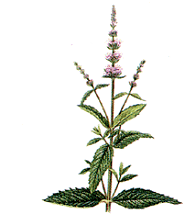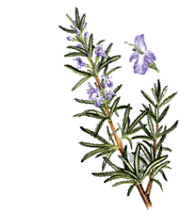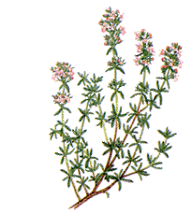

Opening Hours: Monday - Saturday: 9am - 5pm, Sunday: 10am - 4pm MAZE: CLOSED
See Coffee Shop section for their opening hours.
Tel: 0118 972 4220
Peppard Road
Sonning Common
RG4 9NJ
Herbs
Below is a comprehensive list of commonly-stocked herb plants, with the six common herbs - Basil, Lavender, Marjoram, Mint, Rosemary and Thyme - presented first and in some detail. Please note that some varieties of herbs are only available at certain times of the year and others can be in short supply, so all the varieties listed below are subject to availability. For the best selection of plants, visit us during early summer.
Please call or visit and ask a member of staff if you require something that is not on the list and we will do our best to source it for you. To avoid disappointment, please ring us to check availability if you require something specific or are travelling a long distance to get to us.
As well as herb plants we sell a wide selection of herb and wildflower seeds, including some varieties that are not available from us as plants.
We regret we cannot supply mail order.
Basil

This most popular herb will only grow well in this country during warm weather - it likes a steady 15 °C (60 °F) at all times to thrive
All varieties have highly-aromatic leaves
It is an annual plant and therefore should not be allowed to flower; pick off flower buds as they appear
It is probably best grown in a greenhouse or conservatory. Even a light windowsill indoors is often better than outside
Basil does not dry well so to preserve it for winter use place freshly-harvested leaves in a plastic bag directly in the freezer. They can also be preserved by storing them in a bottle of any culinary oil; olive, sesame, groundnut, etc. The leaves can be retrieved when required and the oil takes on the flavour of Basil, which is ideal for dressing.
Lavender

There are many types of Lavender, all of which have highly aromatic foliage and flowers that attract bees and butterflies in mid summer
We have a wide range of varieties from English to French, dwarf to giant and in many shades of blue through to purple, pink, white, red and even green
Modern compact varieties are now the most popular types, more suited to smaller gardens than many of the older varieties that can grow quite large (3-4ft/90-120cm)
All types benefit from being pruned/trimmed occasionally, especially just after flowering to keep the bush compact and in good health
Flowers can be picked for drying as they come into bloom. Use the flowers as flavourings in the kitchen or dry for winter use in pot pourri or sachets
Lavender is a good moth deterrent
Marjoram/Oregano

Marjoram is also known as Oregano and confusion often arises since Oreganum is the Latin name for this family of plants while Marjoram is the English name
What has become known as Oregano in this country is simply Common (or Wild) Marjoram
There are many forms of the herb; the perennials all grow in clumps that slowly spread
The clumps produced by the perennial forms can be dug up and divided during the winter months
All types are very good bee and butterfly attracting plants and have flowers that range from white to deep pink
The herb has many culinary applications, especially in Italian recipes
Mint

There are a great many varieties of Mint. The plant cross-pollinates to produce new strains very easily and this can lead to confusion when trying to identify varieties, of which there are over 600!
All mints have strongly aromatic foliage and spreading root systems, some are very invasive
Most types die down in winter, then reappear the following spring
They are best grown in large pots, in mixed beds they can become a problem
It has been used in religious ceremonies, for flavouring and medicinally by many civilizations going back to the Ancients Greeks and Romans. In Greek mythology, Minthe was a nymph beloved of Pluto. She was changed into this fragrant plant after objections from his jealous wife
Rosemary

Rosemary is an evergreen perennial which can be harvested all year round
All varieties of Rosemary have similar properties. They all have aromatic foliage and can be used in the kitchen for their flavour
Their differences are in their flower colour and growing characteristics and some need a little protection in severe winters
All flower early in the summer and prefer a sunny site in well-drained soil
Plants can get rather leggy if left unattended. They should be pruned occasionally when young to encourage a bushy compact habit and clipped after flowering when more mature to maintain plant vigour
Rosemary can be used fresh or dried for cooking, but it has more flavour when used freshly picked from the garden
Thyme

There are literally hundreds of varieties of Thyme
They can be roughly grouped by their growing habits into three types; Low Creeping (C), Mound Forming (M) and Tall Upright (U) (see below)
Many have aromatic foliage and all have flowers in shades from white to deep pink
All will grow well in dry conditions and prefer a well drained soil
They can be grown successfully in a pot, in rockeries, or between paving slabs
In the kitchen there are really only two flavours that are used; those of ordinary thymes and lemon thymes
There are several different plants that can provide suitable foliage for these flavourings
Other common varieities - not all available please contact if after something specific:
Alkanet
Alpine Strawberry
Angelica
Balm - Lemon and Variegated
Basil - see above
Bay
Betony
Borage - Blue, White and Perennial
Box - Dwarf and Variegated
Burnet - Salad
Catmint
Catnep
Chamomile - Single and Double-Flowered, Lawn
Chervil
Chicory
Chives - Common and Garlic
Chocolate Cosmos
Clary Sage
Coriander - Vietnamese
Comfrey - Common, Dwarf and Variegated
Cotton Lavender (Santolina) - Dwarf, Virens, Viridis,
Small Ness and Lemon Queen
Cowslip
Curry Plant
Dill
Echinacea
Elecampane
Evening Primrose - Biennis and Missouriensis
Fennel - Green and Bronze
Feverfew - Green and Golden
Flax - Blue and White
Fritillary
Garlic
Pelargoniums, scented
Germander
Goat’s Rue
Golden Hops
Heartsease
Horseradish
Houseleeks
Hyssop - Blue, Pink, White and Rock
Indian Mint
Lady's Mantle
Lavender - see above
Lemon Grass
Lemon Verbena
Limanthes (Poached Egg Plant)
Lovage
Mace
Marigold - Pot
Marjoram - see above
Milk Thistle
Mint - see above
Nasturtium
Olives
Oregano - Golden, Greek and County Cream
Parsley - Curly and Plain-Leaved
Pasque Flower - Purple, Red and White
Pennyroyal
Pinks - Cheddar, Maiden and Clove
Pokeroot
Primrose
Purple Loosestrife
Red Orach
Red Perilla
Red Valerian (Centranthus)
Rocket - Salad and Wild
Rock Peppermint (Corsican Mint)
Rock Rose
Rosemary - see above
Sage - Common, Purple, Golden, Tricolour, Pineapple,
Tangerine and Blackcurrant
Savory - Creeping and Winter
Soapwort
Sorrel - French and Broad-Leaved
Sweet Cicely
Tansy - Curled and Plain
Tarragon - French
Thrift
Thyme - see above
Tree Onion
Valerian
Vervian
Violet - Sweet
Viper’s Bugloss
Welsh Onion
Wild Strawberry (Yellow-Fruited)
Wild Wallflower
Woad
Woodruff - Sweet
Wormwood


